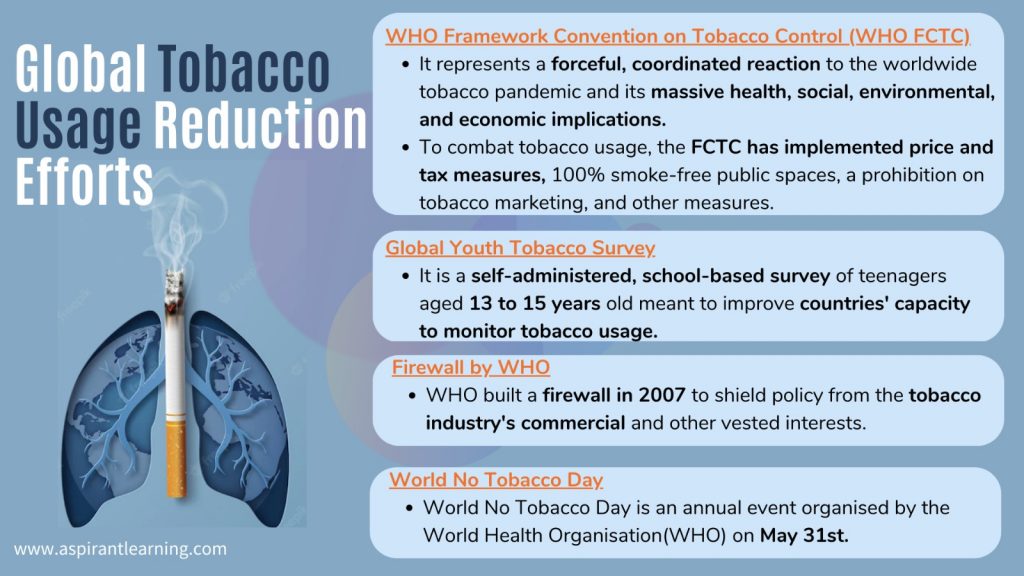News Highlight
The GST system for tobacco taxation is hindering efforts in regulating consumption and protecting public health.
Key Takeaway
- Research in India and around the world supports using taxes to regulate tobacco consumption.
- However, since the adoption of the GST over five years ago, cigarette taxes in India have not grown considerably, making these items more inexpensive.
Status of Tobacco usage in India
- Firstly, India is the world’s second-largest tobacco consumer (268 million).
- In India, 28.6% of adults over 15 and 8.5% of students aged 13-15 use tobacco in some form or another.
- Every year, 13 lakh people die from tobacco-related ailments, and tobacco is responsible for almost 27% of all malignancies in India.
- Tobacco use has been linked to several non-communicable diseases, including cancer, cardiovascular disease, diabetes, and chronic lung disorders.
- In 2017-18, the yearly economic expenses of all diseases and fatalities caused by tobacco smoking were expected to be Rs 177,341 crores or 1% of India’s GDP.
Tobacco Taxation in India
- Overview
- Tobacco items are subject to the highest GST slab of 28% due to the hefty cess.
- The entire tax burden is approximately 52.7% of the final tax-inclusive retail price for cigarettes, 22% for bidis, and 63.8% for smokeless tobacco.
- In addition, the government has formed a panel to develop a comprehensive tax policy plan covering all tobacco products from a public health standpoint.
- The GST revenues from tobacco goods have decreased by 3% in the last two fiscal years.
Significance of increasing the rate of taxation on tobacco products
- The absence of a tax increase means higher profits for the tobacco business and less tax money for the government.
- Tobacco tax revenue might contribute much-needed cash for COVID immunisation drives and health infrastructure improvements.
- Adding an excise levy to all tobacco products and keeping them in the highest tax bracket under GST will lower their affordability.
- This will lay the groundwork for lowering tobacco use among vulnerable populations and preventing children and teens from becoming addicted to tobacco use.
- According to international literature, tax increases are one of the most cost-effective means of limiting tobacco consumption.
- Furthermore, the lack of tax hikes allowed for more current smokers and some new nonsmokers, potentially reversing the downward trend of tobacco prevalence.
- Increased taxes will assist India in meeting the aim of a 30% tobacco use prevalence reduction by 2025, as outlined in the National Health Policy.
Consequences of Tobacco Consumption
- Health Effects
- Tobacco affects practically every body organ and its functions, increasing the chance of cancer, heart disease, and other reproductive and reproduction issues.
- Additionally, smokers are 40-50 per cent more likely to suffer serious disease fatalities from Covid-19.
- Passive smoking, often known as second-hand smoke, endangers the health of individuals who do not smoke.
- Environmental effects: According to the WHO
- Every year, 600 million trees are cut down to create cigarettes.
- There are 84 million tonnes of CO2 emitted into the atmosphere.
- Cigarettes require 22 billion litres of water to manufacture.
- Cigarette butts include hazardous elements such as arsenic, lead, nicotine, and formaldehyde, which leak into aquatic ecosystems and soil.
- Furthermore, E-cigarette trash, unlike cigarette butts, cannot biodegrade even under extreme conditions.
Efforts Taken in India to reduce tobacco consumption
- Cigarettes Act, 1975
- Tobacco control legislation in India dates back to the Cigarettes Act of 1975, which requires statutory health warnings to be displayed in advertisements, cartons, and cigarette packets.
- Prohibition of Electronic Cigarettes Bill, 2019
- It forbids the manufacture, importation, exportation, transportation, sale, distribution, storage, and advertisement of e-cigarettes.
- National Tobacco Control Programme (NTCP)
- The Ministry of Health and Family Welfare launched it.
- The Programme is currently being implemented in all States/Union Territories across the country, encompassing over 600 districts.
- Their objectives are:
- To raise public knowledge about the dangers of tobacco usage and Tobacco Control Laws.
- To aid in the successful execution of tobacco control legislation.

Conclusion
- The impact on the tobacco business will be primarily neutral because the 5% cess declared by the Indian government was less than the predicted rate by the tobacco sector.
- Smokers’ expenses will rise in early time due to the increase in the price of a cigarette.
- However, it is believed that implementing GST will have a neutral effect on the cigarette business, regardless of the tax rate.
Pic Courtesy: The Hindu
Content Source: The Hindu



